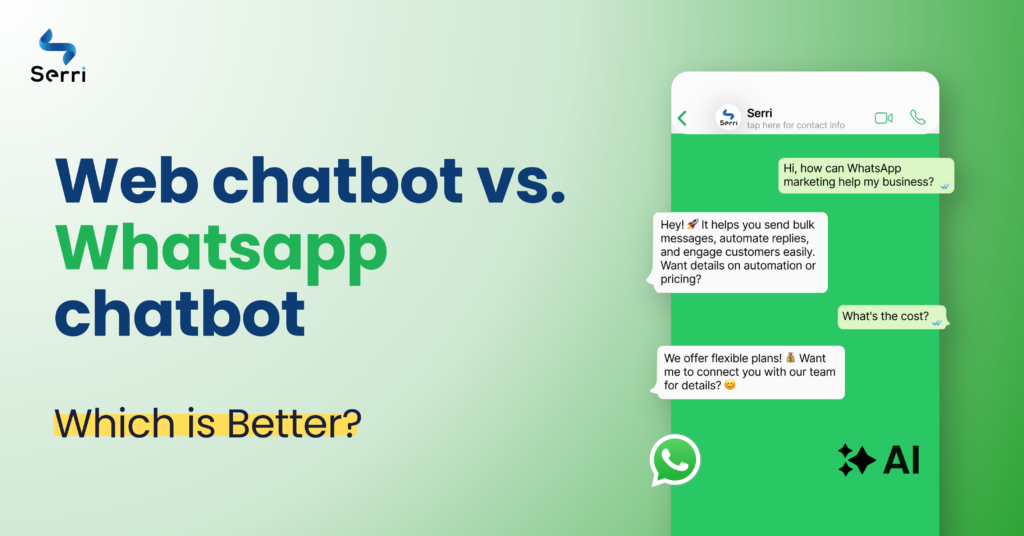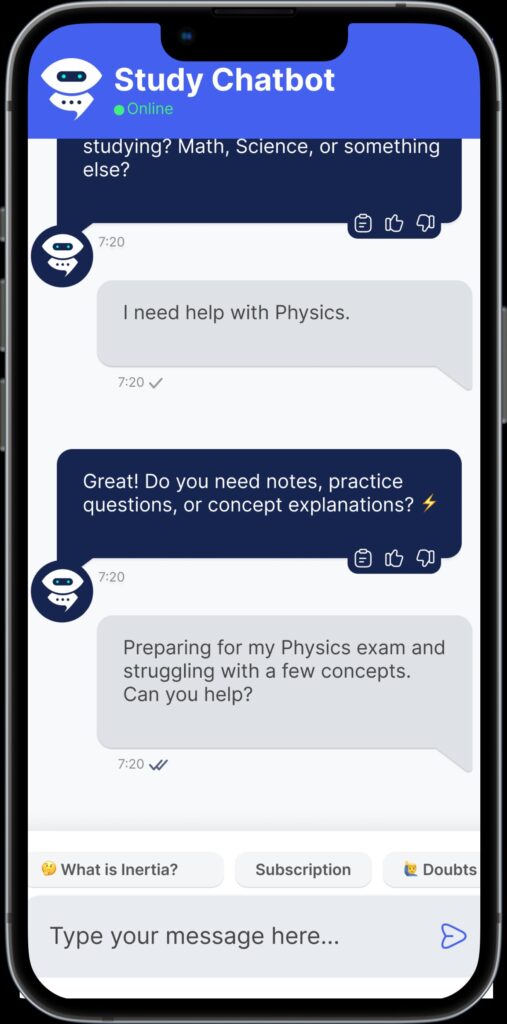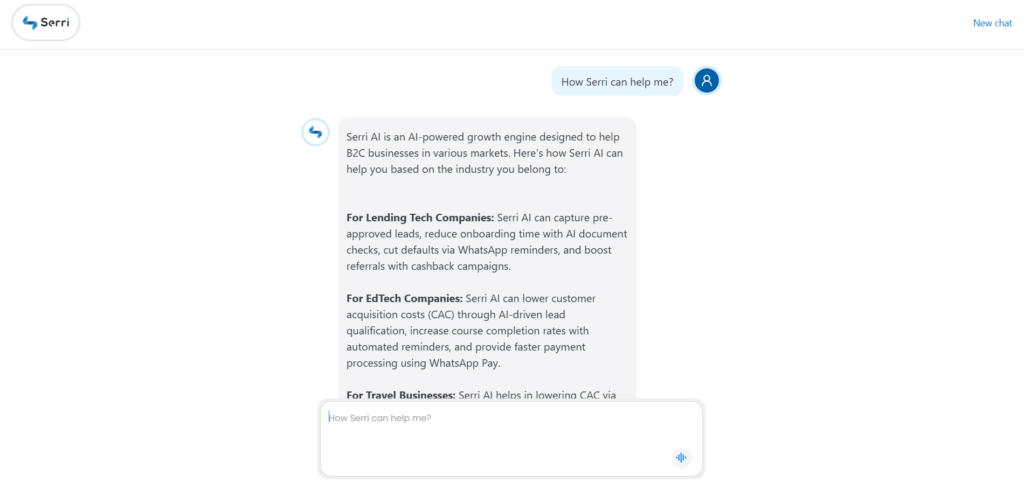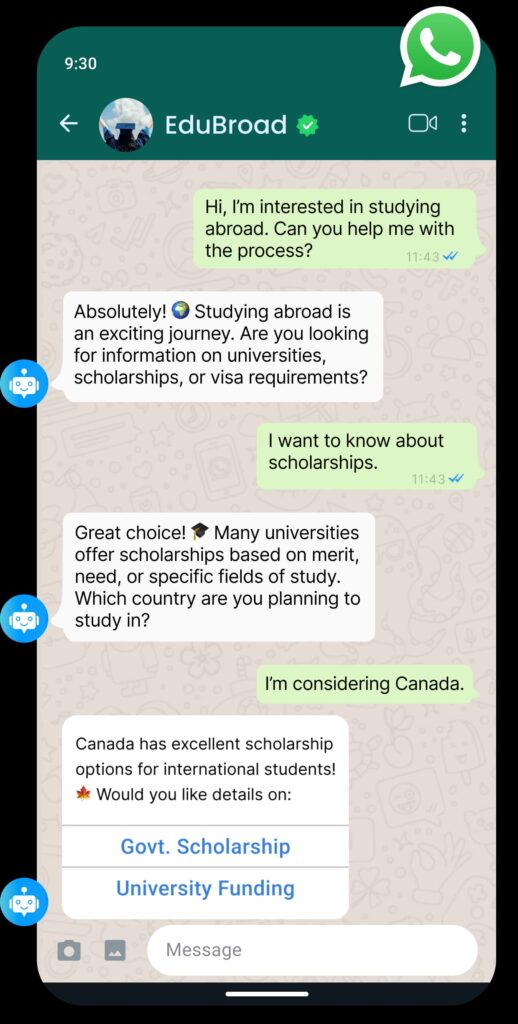
In today’s digital age, businesses are constantly seeking smarter ways to connect with customers and streamline operations. One of the most effective tools for achieving this is the chatbot. But with multiple platforms available, a key question arises: WhatsApp Chatbot or Web Chatbot – which one is better for your business?
Let’s dive deep into the features, benefits, and comparisons to help you decide.
What Are Chatbots?
Chatbots are AI-powered software programs designed to simulate human conversations. You can find them on websites, messaging apps, and social media platforms.

They serve multiple purposes:
- Answer customer queries instantly
- Automate repetitive tasks
- Offer 24/7 support
Chatbots help businesses cut costs, increase efficiency, and improve user satisfaction. They are now widely used for:
- Customer service
- Lead generation
- Appointment scheduling
Web Chatbots
Web chatbots are embedded on a company’s website, allowing businesses to interact with site visitors in real time using natural language processing (NLP) and AI.

Key Features
- Instant Responses: Quickly addresses customer questions.
- Data Collection: Gathers user data and preferences.
- CRM Integration: It easily connects with backend tools and marketing platforms.
Common Use Cases:
- Customer service
- Lead generation
- Product inquiries
- Booking appointments
WhatsApp Chatbots
WhatsApp chatbots operate within the WhatsApp messaging app, making it easier for businesses to connect with customers through a familiar and highly engaging platform.

Key Features
- High Engagement: Benefit from WhatsApp’s 98% open rate.
- Rich Media Support: Share documents, images, and videos.
- Personalized Communication: Customize messages using user data.
Popular Use Cases:
- Order tracking and confirmations
- Customer support
- Promotional messages
- Feedback collection
Web Chatbot vs. WhatsApp Chatbot: Comparison Table
| Feature | Web Chatbot | WhatsApp Chatbot |
| Platform | Website | WhatsApp Messenger |
| Accessibility | Any device with browser access | Requires WhatsApp App |
| User Experience | Formal, structured | Casual, familiar |
| Integration | Seamless with CRM and CMS | Via WhatsApp Business API |
| Customization | Highly customizable | Limited to WhatsApp’s UI |
| Security | Website’s security layer | End-to-end encryption |
| Reach | Limited to website traffic | Massive WhatsApp user base |
| Engagement | Moderate | Very High |
| Personalization | Requires input-based customization | Built-in personalized feel |
| Open/Response Rate | Lower | Significantly higher |
| Bulk Messaging | No restriction | Strict guidelines |
| Dependency | Relies on website traffic | Depends on WhatsApp platform policies |
| Common Use Cases | Lead generation, support, appointments | Updates, marketing, customer service |
| Cost | Varies (self-hosted or SaaS) | Based on API usage and provider pricing |
Advantages of Web Chatbots
- Platform Independence: Accessible from any device with internet access, making them platform-independent.
- Ease of Integration: Easily integrate into existing web infrastructure, including CRM and email marketing systems.
- Broad User Reach: Can interact with anyone visiting the website, offering a wide reach.
Advantages of WhatsApp Chatbots
- Personalization and Engagement: Offer a more personal touch, engaging users in a familiar chat environment.
- High Open and Response Rates: Messages sent via WhatsApp are more likely to be opened and responded to compared to emails or web notifications.
- Leveraging WhatsApp’s Popularity: With billions of users worldwide, WhatsApp chatbots can reach a massive audience.
Challenges of Web Chatbots
- Dependency on Website Traffic: Web chatbots rely on website visitors, limiting their reach to people who are already aware of the business.
- Limited Immediate Reach: They may not provide instant engagement compared to messaging apps, where notifications are more promptly seen.
Challenges of WhatsApp Chatbots
- Restrictions on bulk messaging: WhatsApp has a strict policy on bulk messaging, which can hinder marketing campaigns.
- Relying on WhatsApp’s Platform Policies: Businesses must follow WhatsApp guidelines to change and influence performance.
How to Choose the Right Chatbot for Your Business
1. Assess Your Business Needs
Figure out what you want to achieve with a chatbot—customer service, lead generation, marketing, etc.
2. Consider Your Target Audience
Identify where your audience is more active—on your website or WhatsApp.
3. Allocate Budget and Resources
Think about the costs and resources needed to set up and maintain the chatbot.
Discover Serri: Boosts Your Business with WhatsApp Chatbots

Serri helps businesses create their own WhatsApp Chatbot. It’s user-friendly and packed with features, allowing you to design a chatbot that meets your needs.
Here’s what Serri offers:
- Quick Setup: Get your WhatsApp Chatbot up and running quickly to start serving customers right away.
- Personalized Conversations: Craft messages that truly connect with your audience, boosting engagement and satisfaction.
- Scalability: Serri handles a large volume of customer interactions, making it easy to grow your operations.
- Data Insights: Gain valuable insights into customer behavior with detailed analytics, helping you improve your services.
Final Thoughts: Step into the Future with Chatbots
Whether you pick a web chatbot or WhatsApp chatbot, the goal is to enhance user experience and simplify operations.
WhatsApp chatbots offer deeper engagement, while web chatbots provide flexibility and cost-effectiveness. With platforms like Serri, building a chatbot tailored to your business has never been easier.